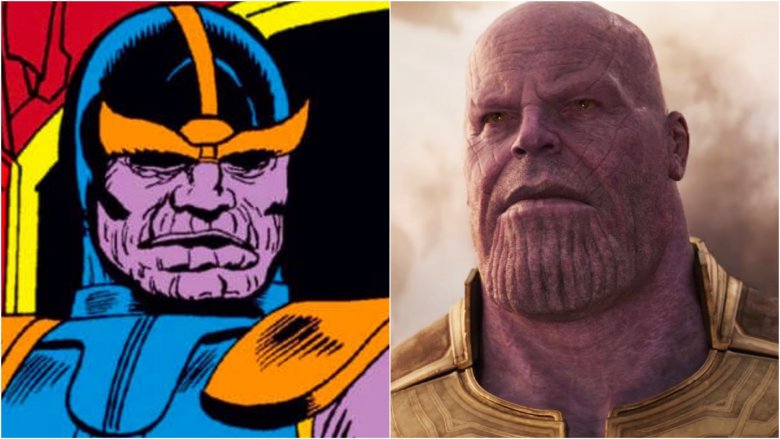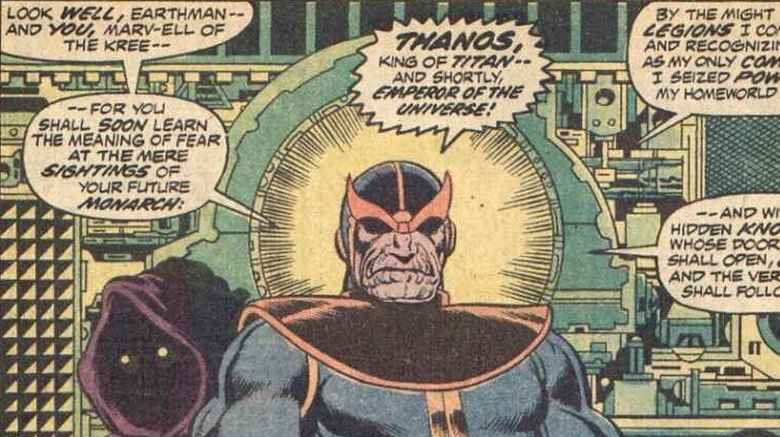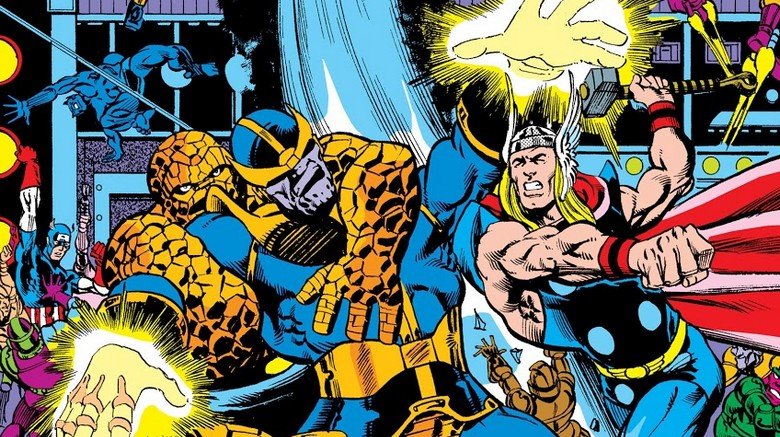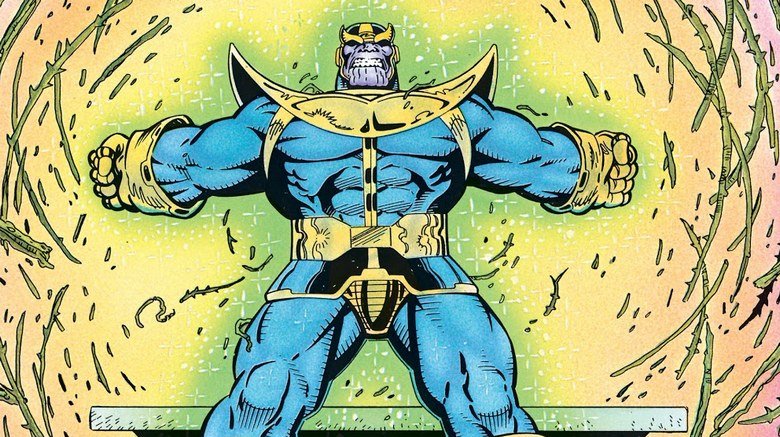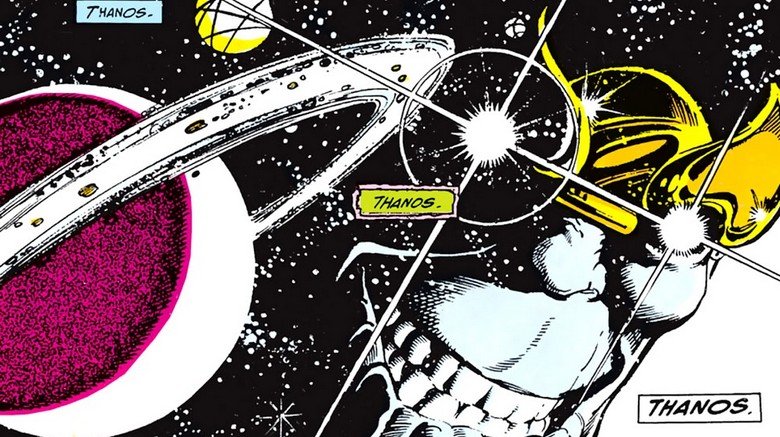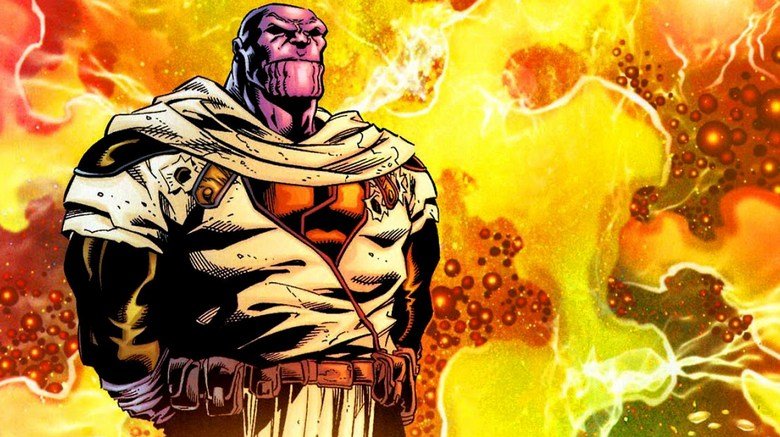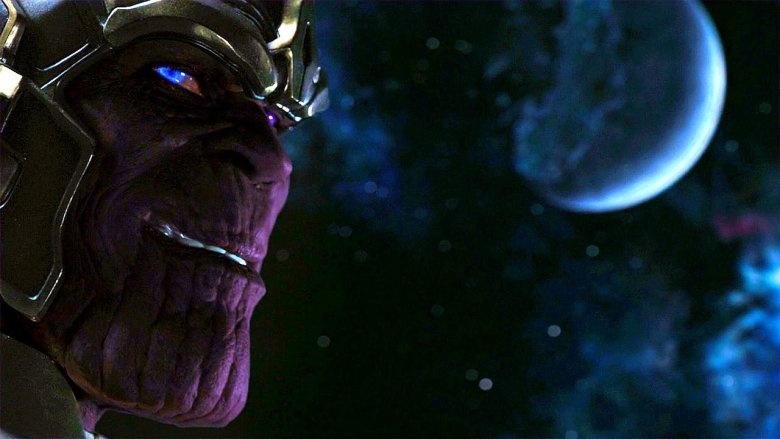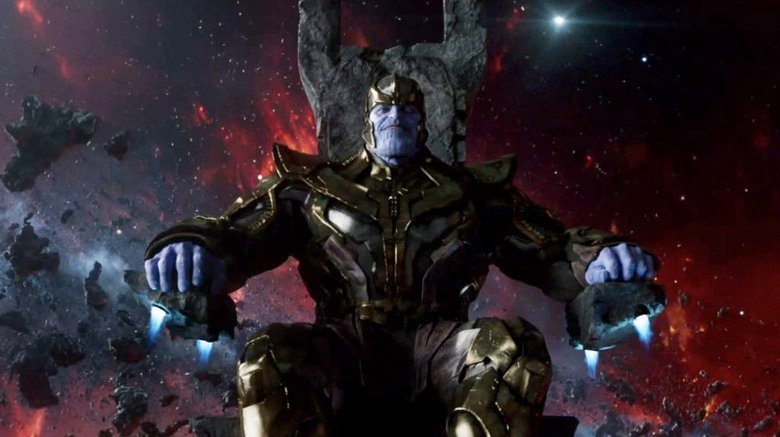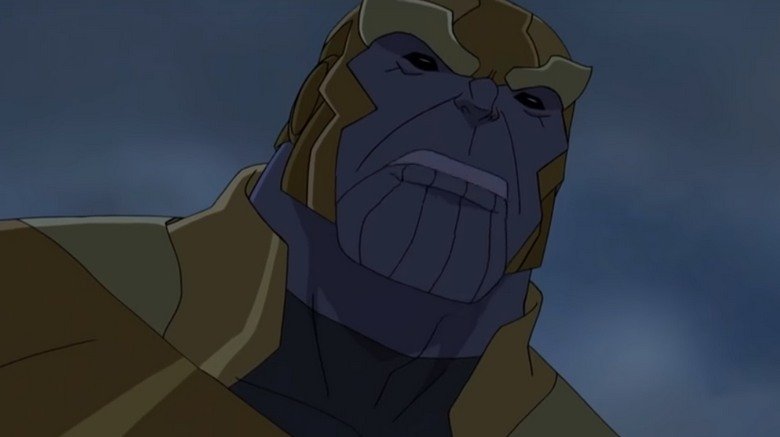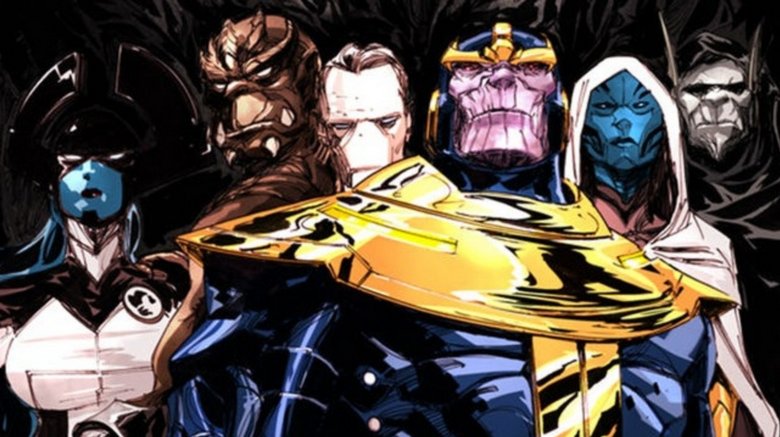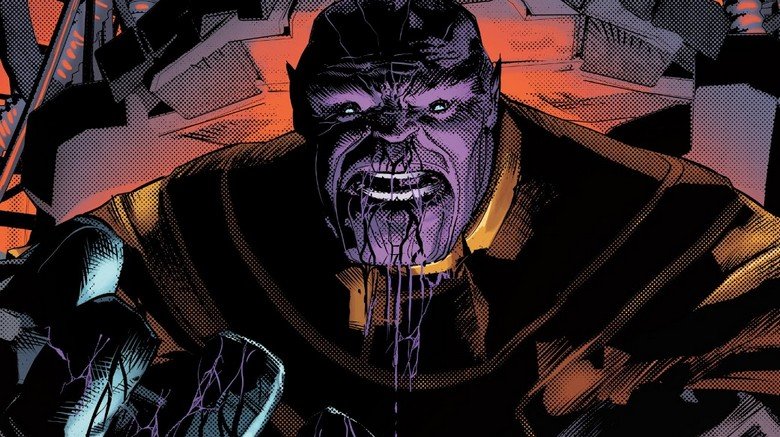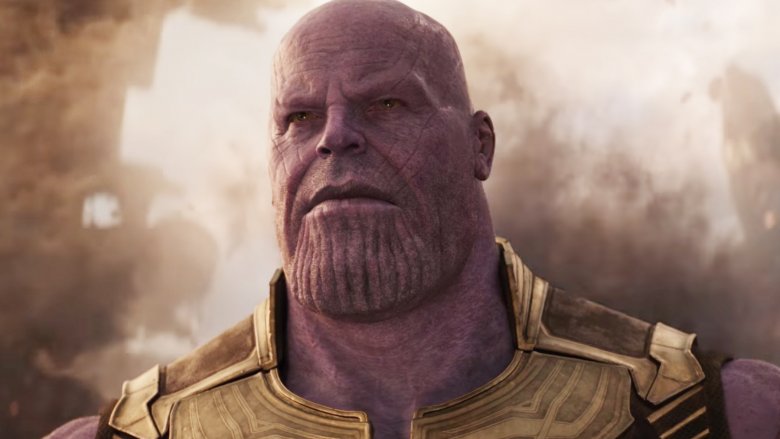The Evolution Of Thanos
You don't need to be an old school Marvel Comics fan to know the Thanos we saw in 2018's Avengers: Infinity War has evolved since his creation. Even if all you know about Marvel's mythos is from the movie screen, the character's changes are apparent: The Thanos from that first Avengers mid-credits scene is clearly not the same guy tossing the Hulk around like a rag doll in the beginning of Infinity War.
Created by Jim Starlin and first appearing in 1973's Iron Man #55, the villain Thanos appears all over popular media — not only in comics and films, but in over a dozen handheld and console video games as well as animated television series. The Mad Titan even got his own prose novel in 2017 and a second — tied to the MCU character — hits shelves in November 2018.
Many of the villain's basic traits have remained intact over the years: he's alien, powerful, merciless, and purple. But he's changed in other, often more subtle ways. Thanos' appearance, motives, and emotional journey changed dramatically between his faceoff with Iron Man and Drax in 1973 and his war with the Avengers in 2018.
Here's the evolution of Thanos, the Mad Titan.
The birth of the Titan
One thing about Thanos remains constant: he prefers working from the shadows long before face-to-face confrontations. His first appearance is a perfect example — in that it may not actually be his first appearance. When Iron Man punches the Thanos of 1973's Iron Man #55, we learn it's actually a robot duplicate; it's possible the real Thanos never appeared in the issue at all. We see a flashback of Drax battling Thanos, and before that we see the villain from behind as he taunts the Destroyer. We have no way of knowing if either of those were the genuine article. The first time we know for sure we're seeing the true Thanos is a month later in Captain Marvel #25, and only in the shadows as he relays orders to his Skrull cronies.
We see the Titan in his full glory for the first time in Captain Marvel #26, flanked by the lady Death and the Super Skrull. The most obvious physical difference is that he's much thinner than he would later appear, and the ridges of that famous chin aren't quite so prominent. In the first full-page shot of Thanos it doesn't even appear that they're ridges at all, just the randomly placed wrinkles of a purple-faced villain.
Thanos' creator, Jim Starlin, created both Thanos and Drax the Destroyer before working at Marvel. Starlin said that, once hired at Marvel, he wasn't sure how much of a chance he'd get to feature characters all his own, so he shoved Thanos and Drax in Iron Man #55 right out of the gate.
The fall of Thanos
Thanos made trouble around Marvel's spaceways until fate and a whole bunch of superheroes caught up with him in the classic Marvel Two-In-One Annual #2. Spider-Man, The Thing, Adam Warlock, and The Avengers confronted the Mad Titan and the conflict gave Thanos his first "death" — and his most significant, considering it lasted over two decades.
Physically, Thanos was a lot thicker in 1977. This was at the urging of editor Roy Thomas. In spite of popular belief, Thanos was not initially inspired by DC's Darkseid. Starlin said it was the New God Metron the Titan most closely resembled until Thomas told him, "Beef [Thanos] up! If you're going to steal one of the New Gods, at least rip off Darkseid, the really good one!"
Marvel Two-In-One Annual #2 is the first time we see the pure physical might Thanos wields. In previous appearances when he went toe-to-toe with other characters, he was often powered by one of the many cosmic artifacts he was always hunting, like the soul gems or the cosmic cube. But in that classic 1977 comic, we see him take on two of Marvel's heaviest hitters — Thor and the Thing — at the same time. The pair seem to have him on the ropes at first, but eventually he's able to swat them aside, knocking the Thing unconscious with a single power blast from his eyes.
The Return
Thanos would wait over two decades to come back to life in 1990's Silver Surfer #34, but it would be worth the wait. The return would herald a spike in the villain's popularity, as well as multiple line-wide events featuring the Mad Titan. Shortly after coming back to life, Thanos faked his own death in order to pursue the soul gems without worrying about Silver Surfer or any other heroes. His retrieval of the gems in order to woo Mistress Death was told in the two-issue miniseries Thanos Quest, which acted as a prologue to the pivotal Infinity Gauntlet.
Thanos Quest, written by Thanos creator Jim Starlin and drawn by Ron Lim, beefed the Mad Titan up even more, making him look Hulk-sized. The signature ridged chin lengthened, taking up almost as much space as the rest of his face.
His physical appearance notwithstanding, what makes Thanos Quest one of the most important series in terms of the character's growth is that it's the first time we get a story told from Thanos' point of view. At the time, almost all of the gems were held by members of the Elders of the Universe, including the Collector and the Grandmaster. One by one, Thanos visits each soul gem custodian and takes his prize. Through it all, we get narration from the Mad Titan himself, and get to know the true scope of his intelligence and cunning, his love for Mistress Death, and the sadistic joy he revels in as he defeats his rivals.
Infinity Gauntlet
With all the soul gems in his possession and the unlimited power that came with them, Thanos kicked off the line-wide event Infinity Gauntlet and accompanying miniseries by fulfilling his promise to Mistress Death and killing half the living beings in the universe with a single snap of his fingers. With the power of the Gauntlet, Thanos not only easily defeated Thanos' surviving heroes but also withstood an assault by an assortment of the most powerful cosmic beings in Marvel's pantheon — Galactus, Eternity, The Stranger, Zeus, and Odin to name only a few.
The event would do much to shape the Marvel Universe to come, and it proved to be one of the primary inspirations for the film Avengers: Infinity War. Infinity Gauntlet spawned two sequels — 1992's Infinity War and 1993's Infinity Crusade, both of which were line-wide events — as well as the ongoing series Warlock & The Infinity Watch.
Infinity Gauntlet set up Thanos as the super-villain of the Marvel Universe. No other villain had ever wreaked as much havoc to the joy of Marvel's readers. Ironically, it also saw the beginning of Thanos' character moving in an entirely different direction.
Redemption
Thanos was a key figure in both of Infinity Gauntlet's sequels, but as an uneasy ally to Earth's heroes rather than an enemy. The Titan never truly seemed to be "on the side of the angels." Thanos sided with heroes when it benefited him in some way, even if it was nothing more than the fact that a threat to the universe also threatened him — as Star-Lord might say — as "one of the idiots who lives in it."
Thanos' willingness to side with former enemies proved more common throughout his appearances in the '90s and early aughts. He helped alliances of heroes save the universe in 2002's Infinity Abyss and 2003's Marvel Universe: The End. He helped Adam Warlock and his allies in Warlock & The Infinity Watch and was willing to put aside old differences with Thor to team with him and Genis-Vell in Captain Marvel. Further complicating things, he was still more than willing to be a bad guy taking on Thor, Ka-Zar, the Hulk, and more if it suited his purposes.
In 2003, Thanos got his first ongoing solo title. Thanos lasted 12 issues, and the second half of the series brought a dramatic change to the Titan's wardrobe. Discarding the classic blue-and-gold uniform along with its headpiece; Thanos dressed in soft, light colors that made him look more like a seasoned traveler than an intergalactic conqueror. The look survived until the 2006 event Annihilation, which saw the Titan once again allying himself with Marvel's heroes. Unfortunately, Drax killed Thanos by ripping his heart from his chest before the Titan could help all that much.
Courting Death
Interest in Thanos spiked again with the release of 2012's game-changing Avengers. He wasn't in any trailers or TV spots, but he was the sponsor of Loki's machinations, as revealed in the Avengers mid-credits scene.
The film realization of Thanos wasn't developed fully yet. Right before that profile shot that got all the comics fans cheering, we see a very real and very human-sized hand push Thanos up from his throne, as opposed to the big, meaty purple fists that were knocking around the Avengers in Infinity War. Josh Brolin had yet to be cast in the role; the Mad Titan of Avengers was instead played by Damion Poitier, a.k.a. Duprez of HBO's True Blood.
At the 2018 San Diego Comic-Con, Avengers writer/director Joss Whedon admitted he didn't really understand Thanos or his motivations. Speaking to IGN, Whedon said, "I love Thanos ... and I'm like, Thanos is the ultimate Marvel villain! And then I was like, I don't know what I would actually do with Thanos." Whedon went on to say he was impressed with how Joe and Anthony Russo handled the character in Infinity War.
The guy in the chair
After 2012's Avengers, we didn't see the film version of Thanos again until 2014's Guardians of the Galaxy. With Josh Brolin now in the role, we got to hear the big-screen version of the character speak. His appearance is brief, however: we see him in one dialogue scene with Ronan and Nebula, and even more briefly later, he yells at Ronan over a hologram communicator.
The Thanos of Guardians looks and acts much more like what we would expect from a film version of Infinity Gauntlet. Still, even in his short time in Guardians of the Galaxy, much of the foundation for Infinity War is laid in Thanos' single dialogue scene. From his comments to Ronan we know his concerns are cosmic, because how else could you consider the destruction of an entire planet "petty?" The toxic relationship between Thanos and Nebula is established in that scene, as is the Titan's inexplicable love for Gamora.
Physically, Thanos doesn't look that different from the classic comic book version. Unlike Avengers, he's fully CGI in Guardians. In spite of the fact that he never gets up from his chair, you can sense the confidence and power in the villain. You know when he threatens to "bathe the starways" in Ronan's blood that he could do it.
The voice of Thanos
You may know Isaac Singleton Jr. better as Bo'Sun in Pirates of the Caribbean: Curse of the Black Pearl or even as Boothe from Deadpool (the guy Wade Wilson tries to get killed in the beginning of the film so that he can win Sister Margaret's Dead Pool), but he's also a prolific voice actor who's threatening to become to Thanos what Mark Hamill became to the Joker.
If you're a fan of Marvel's cartoon series, then you're likely to have heard Singleton's deep and commanding voice in either the animated Guardians of the Galaxy or Avengers Assemble. He also voiced the Mad Titan in the two LEGO Marvel Super-Heroes TV shorts: Guardians of the Galaxy – The Thanos Threat and Black Panther – Trouble in Wakanda.
Singleton's first experience voicing Thanos wasn't for an animated series, however. He voiced the Mad Titan in 2008 for ZEN Pinball's "Infinity Gauntlet" level, and reprised the role in Marvel Pinball: Avengers Chronicles, Disney Infinity 3.0, LEGO Marvel's Avengers, and Marvel vs. Capcom Infinite.
A little help from my friends
The 2013 line-wide event Infinity gave Thanos something he'd never had before — a group of dedicated followers.
Before Infinity, Thanos didn't have disciples as much as he had pawns. Early appearances showed him manipulating super-villains like the Controller and the Super-Skrull, or hiring armies of alien mercenaries. But the Black Order of Infinity was the first time Thanos had a group of vicious, powerful servants dedicated to his service. The beginning of Infinity sees Corvus Glaive visiting different alien worlds to collect "tribute," i.e. the male offspring of entire species. Glaive and the rest of the Order are willing and able to raze entire worlds if the tribute is not met.
Some members of the Order don't survive Infinity and, because ultimately they are each as black-hearted as their master, some betray him. Regardless, this was a significant change for the character who in 1990 gathered all the soul gems by himself with no one to help him but a flying chair.
Death and rebirth
Thanos scored his second ongoing solo series in 2016, and any redemption gained in his '90s appearances was cast aside. Freshly returned from yet another death, Thanos opens the series by taking back control of a planet that was seized by his Black Order servant, Corvus Glaive. Thanos is the most brutal he's ever been as he tears through Glaive's forces, and his former servant ultimately commits suicide rather than face the end Thanos would have given him. The issue ends with the reveal that Thanos is dying, and later in the series we learn that the source of his illness is Mistress Death.
Lemire's version of Thanos differed the most from previous iterations in that he was much more "hands on." Thanos didn't raise an army or form a new Black Order to take back a world from Corvus Glaive — he did it himself, and he did it alone. His advanced intelligence remains, but he's never seemed as much of a warrior as he does in Lemire's Thanos. Far from the villain in the shadows from his earliest appearances, this Thanos — much like the Thanos we would see in Infinity War — revels in battle and bloodletting. If Iron Man punched this Thanos, he wouldn't turn out to be a robot. He'd smile and punch Shell-head right back — probably through two or three moons.
Infinity War
Avengers: Infinity War's realization of Thanos is the most compelling and complex iteration yet. Joe and Anthony Russo kept Thanos' brutality, his ruthlessness, his power, his bloodlust, and his need for the infinity stones. Discarding his crush on Death, the Russo brothers made Thanos a madman with a motivation that wasn't all that mad. Thanos' purpose is concrete and believable – to kill half the living beings in the universe to render all life more sustainable. He is insane, But for a genocidal maniac, his motives are as valid as you get.
Physically, they did away with his classic uniform and gave him an outfit more like what we saw in the second half of his first solo series — a smart choice that helped to humanize him. During close-ups of his face, we also see that they've added a good deal of scarring along with the famous chin ridges, implying he's a veteran of plenty of battles.
Josh Brolin evoked an emotional complexity we've never seen in any version of Thanos. While we're never fooled into thinking he's anything close to a good guy, his love for Gamora seems tragically genuine. And while he is a sadist and a genocidal maniac, he feels some sympathy for his enemies, at least for those who — in his eyes — prove worthy. When Thanos tells Stark that he hopes his people remember him, he doesn't seem to be toying with Stark or being sarcastic. He means it, even though it won't stop him from killing Stark... or anyone else.
